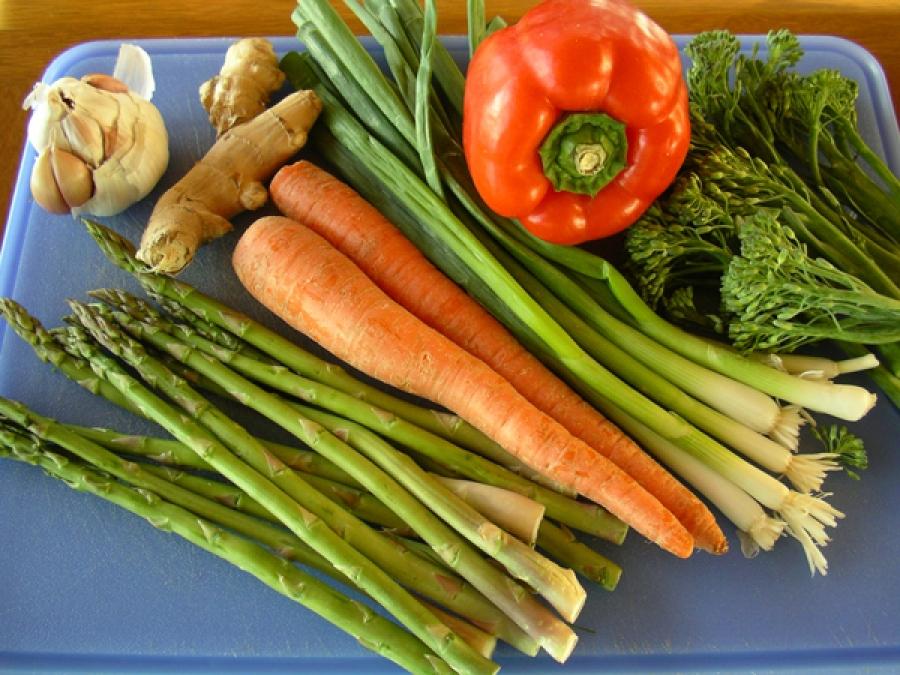Stir-fry sauces transform everyday chunks of protein and vegetables into dinners that vibrate with flavour. Colourful, nutritious and infinitely variable, this recipe is perfect for boaters. As long as you have the basic ingredients on board, you can forage for the rest. Wherever there’s a roadside (or dockside) stand or market, you will find good candidates for this quick, easy meal.
My recipe has evolved and as you experiment to find your favourite combinations, it will continue to evolve. When I was in college, my roommate and I gave each other Chinese cooking lessons as a holiday gift. Both of us had grown up on meat and potatoes, and it didn’t take long to decide that learning any style of cooking would improve our rudimentary culinary skills. We bought green tea and a teapot, soy sauce, sherry, garlic and ginger, and settled in to practice. My typewritten and stapled Chinese cookbook soon sported translucent grease spots and brown splotches no longer identifiable as chicken, beef or tofu; and I eventually threw it away, confident that I knew what to do without it. I wish I had kept it, if only to compare what I cook now to those first recipes. But it’s hard to go wrong as long as you keep the flavours in balance and suitable to your own tastes.
When out cruising, keep a few essential ingredients on hand: soy sauce, cornstarch, ginger, garlic and rice. Sesame oil is delicious, but not very versatile, so if you have space, bring it along. Otherwise, use a good all-purpose vegetable oil such as avocado or extra virgin olive oil. If you don’t have sherry, substitute a good white wine. Avoid cooking sherry. I have come to believe that if it’s not good enough to drink, then it’s not good enough to put in the food. To this basis, add whatever fresh vegetables you find, and meat, shrimp or tofu. Canned ingredients such as water chestnuts, pineapple, baby corncobs or artichoke hearts can fill in or augment fresh produce.
If possible, include some green veggies as well as reds, oranges or yellows. If your plate comes to the table looking bright, colourful and appealing, you’ve included a good mixture of nutrients. This rule of thumb makes it hard to go wrong, and from now through summer, we will have an abundance of produce to choose from, even on many of the smaller islands.
In April, plump local asparagus appears in Northwest markets. Paired with tomatoes, carrots or red bell pepper, the colours both tempt the palate and advertise a variety of vitamins and minerals. It’s perfect with chicken or tofu, and not bad with pork and beef. I often combine hearty vegetables such as broccoli with beef and spice up the sauce. Mildly flavoured vegetables go especially well with tamer protein; for example, snow peas taste delicious with shrimp or chicken. But just as often, I break that rule. The fact is, all vegetables work with all types of protein and the sauce in this month’s recipe can be varied to suit what you have on hand as well as the folks who will be eating it. Spice it up by increasing the ginger and garlic or adding red pepper flakes. Spice it down by reducing those same ingredients, or by reducing the amount of sauce you use.
Ingredients for two servings
- 1 large or 2 smaller boneless skinless chicken breasts, or equivalent amount of pork, beef, shrimp, or firm or extra firm tofu
- Assorted vegetables, enough for two generous portions
Sauce
- Note: If refrigerated, this will keep for about a week. I like to double it to make enough for a couple of meals.
- ¼ cup chicken broth
- ¼ cup sherry or dry white wine
- 2 tablespoons soy sauce
- 1 ½ teaspoons cornstarch
- 1 teaspoon sesame oil, olive oil or other good quality vegetable oil; more for cooking
- ¼ teaspoon red pepper flakes
- 1 tablespoon finely minced garlic
- 1 tablespoon finely chopped ginger
Optional
2 tablespoons Hoisin sauce
Method
- Set aside the ginger and garlic.
- Combine remaining sauce ingredients in a small bowl.
- Cut chicken, beef or pork into even, bite-sized pieces.
- If using tofu, cut block into 1-inch slices, place the slices on several layers of paper towels, cover with more paper towel; then place a cutting board on top. Weight the cutting board with a heavy pan or two large cans (such as 28-ounce cans of tomatoes) for about 30 minutes. Then cut each slice into 1-inch squares.
- Clean the vegetables and cut into equal sizes.
- Coat the bottom of a 12-inch frying pan or wok with oil and heat the pan over high heat until the oil shimmers.
- Add the meat or tofu and brown it, working in batches if necessary to prevent crowding.
- Turn, and cook until almost cooked through. Season to taste with salt and pepper. If using shrimp, sauté until bright pink and almost cooked.
- Remove from pan. Keep warm in a clean bowl.
- Again coat the pan with oil and add the vegetables that take the longest to cook. If cooking broccoli, carrots or other tough vegetables, add a splash of broth or water, cover, and steam for 2–3 minutes.
- Add remaining vegetables, reduce the heat to medium high and stir-fry until crisp tender.
- Reduce the heat to medium.
- Push the vegetables to the sides of the pan, making a clear space in the centre.
- Add a teaspoon of oil in the centre, then the ginger and garlic.
- Sauté until the garlic is golden.
- Add the stir fry sauce and gently toss with the vegetables.
- Add the shrimp, meat or tofu, and stir to coat.
- When it’s all steaming hot and cooked through, serve over rice.
- Have fun this summer foraging for ingredients. Bon appétit!
